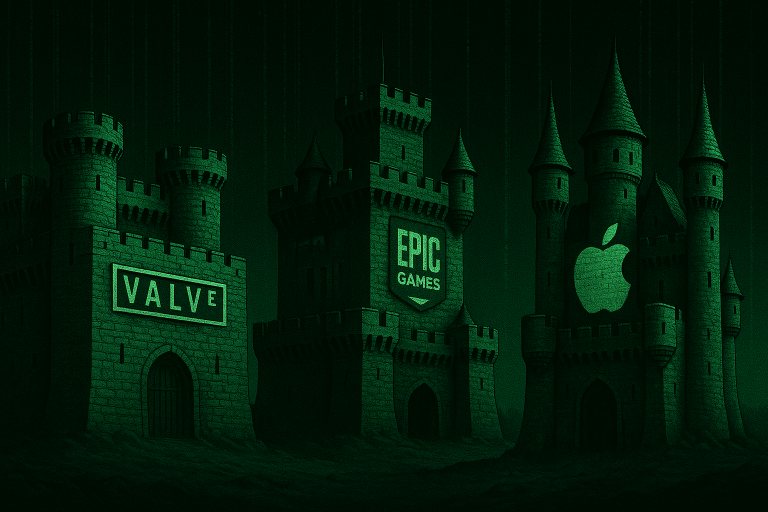I first saw The Matrix in my early twenties — like most people in games around that time. It’s aged into meme territory now, but I’ve rewatched it over the last two decades enough that, along with the trench coats and the bullet time, some of the lines occasionally wander in.
“The Matrix is a system, Neo… When you’re inside, you look around, what do you see?”
That idea — of being so embedded in a system you stop noticing it — has never felt more relevant. Not because anything’s hidden or secret. Quite the opposite, in fact. Over the past twenty years, the structure of the games industry has shifted in full view. Platform by platform, policy by policy, it’s taken on a shape that’s increasingly hard to ignore.
Recently, that shape snapped into clearer focus while reading Yanis Varoufakis’ Technofeudalism. It’s not a book about games, but it offers a language that resonates deeply with what many of us have experienced: a quiet shift from open markets to controlled systems.
Platforms as Lords of the Domain
Varoufakis suggests we’re not just post-capitalist — we’re post-market. In this new model:
- Platforms don’t produce value — they own the means to distribute and monetise it
- They extract rent by controlling access to creators and users
- Algorithmic visibility replaces price and competition as the core organising force
This may sound lofty, but it feels oddly familiar. Valve, Apple, Epic — they all operate as gatekeepers. They decide who gets in, how content is surfaced, and what the cut is. That cut is usually around 30%. You’re not selling into a market. You’re entering a domain — one with rules and rulers.
Steam is the clearest example. It began as a patch delivery system. It evolved into a storefront. Now, it’s a managed ecosystem: monetised wishlists, algorithmic discovery, community-run marketplaces — all governed from the centre. Once you’re inside, you play by its rules.
“The platform isn’t just a tool anymore. It’s the terrain.”
A System We Watched Take Shape
What’s important here is that none of this happened suddenly. There was no bait and switch. Each step made sense at the time:
- Steam offered distribution at global scale
- The App Store solved discoverability for millions of mobile users
- User-generated economies (TF2 hats, Roblox assets) gave creators new paths to participate
But as the systems matured, the centre of gravity shifted. We moved from value creation to rent extraction. Platforms monetise what others build — often with minimal marginal cost — while retaining tight control over visibility and monetisation.
A small, real-world example: I’ve watched more than one team agonise over whether to release on a Thursday (good wishlist conversion) or a Monday (bad visibility decay). These aren’t creative decisions — they’re system moves. Strategy in a machine.
Roblox’s revenue model, for instance, shows just how far this logic has scaled. The creators do the building; the platform sets the rates, handles transactions, and takes its share. It works. But it also captures enormous value from work it didn’t produce.
Algorithmic Discovery and Creative Constraint
None of this would matter quite so much if discovery were fair and transparent. But increasingly, visibility is determined by metrics we can’t see, can’t predict, and can’t shape directly.
Steam’s algorithm, for example, rewards early engagement, rapid wishlist-to-purchase conversion, and sustained activity — but in ways that aren’t always legible. Developers optimise for momentum, not necessarily meaning. Features are designed to trigger system reactions. Retention becomes king.
It’s not that platforms discourage creativity — it’s that the incentives now shape creativity. Not overtly. Just gradually. Design decisions become discovery decisions. You tweak your store assets not for players, but for the algorithm.
And again, this isn’t sinister. It’s just structural.
Irreversibility in a Managed Economy
When systems like this evolve, they tend to entrench. The more valuable they become, the more tightly they’re managed — not out of greed, but out of necessity.
Valve’s crackdown on CS:GO skin gambling is a good example. It wasn’t planned. It emerged from the community. But once it started to spiral, Valve had no choice but to assert control. That control hardened over time. APIs tightened. Market access shrank. The ecosystem remained viable — but less open.
Once systems start needing management, openness declines. The logic of self-preservation takes over. And with that comes more rules, less flexibility, and more rent.
Seeing the System, Not Escaping It
This is where The Matrix analogy returns — but gently. I’m not suggesting we’re trapped or plugged in. Just that we’re inside something structured, and that structure wasn’t designed around our needs as creators. It just emerged, piece by piece.
I readily accept that it’s not for me to define how people have fun. Many of these systems provide relaxation and joy to many. I also accept that to many now, not having these options is a deal breaker for when chosing the type of entertainment they desire.
We don’t need to unplug. But we do need to see the platform economy for what it is: not a marketplace, but a managed environment. That distinction matters, because it shapes how we plan, build, and try to sustain ourselves.
Are There Alternatives?
We’re probably not going to build a perfect, decentralised utopia. But there are already experiments worth noting:
- itch.io continues to offer a radically open publishing model, which is interesting
- Some developers are exploring direct sales, patronage, and cooperative funding
- Discovery is shifting (slowly) toward creator-led ecosystems — newsletters, Discord, social
None of these replace Steam or the App Store. But they do point to something important: if we understand the system, we might stop trying to beat it — and start designing around it.
Final Thought
Varoufakis’ Technofeudalism gives us a language, not a solution. And that’s fine. Because the point of this piece isn’t to rally against platforms or cry foul, it’s simply to say:
Look at what we’ve built. Look at where we’re working now.
We didn’t just build with platforms. We built inside them. And the clearer we see that, the more honest we can be about what it means to create — and survive — in a platform-first world.



